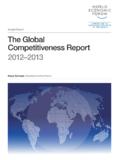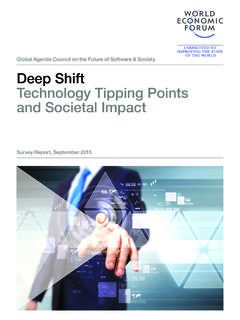Transcription of White Paper Addressing E-Payment Challenges in Global E ...
1 White PaperAddressing E-Payment Challenges in Global E-CommerceMay 2018 World Economic Forum 2018 All rights part of this publication may be reproduced ortransmitted in any form or by any means, including photocopying and recording, or by any information storage and retrieval 170518 - case 000360753 Addressing E-Payment Challenges in Global E-CommerceContents 3 Introduction3 The evolving e- payments system 4 Participants: The demand and supply side4 E- payments and e- commerce : The opportunities 5 E- payments and e- commerce : The challenges7 E-Payment regulatory principles 8 Underlying infrastructure 8 E- payments and trade policy 8 Unpacking trade in services 9 Applying the GATS to E-Payment services 11 Surveying trade policy developments 13 What next?
2 14 Acknowledgements 15 Endnotes IntroductionPayments have been a critical part of the daily lives of individuals, businesses and governments for over two millennia from the first coin minted around 600 BC, which steadily replaced barter and exchange, to the rise of the cryptocurrencies that capture headlines today. The history of payments is characterized by constant technological and societal change, as well as by increasing indispensability to economic activity.
3 Modern technological developments have altered the way consumers interact with financial institutions, disrupting the payments system. The rise of the internet, digitization, shifting consumer preferences and, in some but not all cases, regulatory reform, has accelerated the uptake and use of electronic payments (e- payments ).1 Once dominated by banks, the sector is witnessing both increasing competition from new entrants and the emergence of E-Payment methods that involve partnerships among different players, from telecom operators to express delivery companies and retail agents. The acceleration of e- payments has supported e- commerce and brought significant benefits.
4 For small businesses, the combination of e- payments and other online tools can mean easier access to a much wider customer base throughout a country or region, or across the globe. In turn, this has provided customers with greater convenience and choice. However, while the digital world is theoretically borderless, national and regional boundaries have not gone away. Global e- commerce still faces a range of Challenges . Restrictions on the international supply, use and availability of E-Payment services are among them. This White Paper aims to inform discussion on E-Payment Challenges and solutions in the context of Global It provides brief context on the E-Payment system, the opportunities the sector presents for small business Global e- commerce and the payment-related hurdles faced by players dealing digitally across borders.
5 The Paper then surveys some regulatory principles that could ensure accessibility and security for users, efficiency for e- payments processing and proportionate prudential oversight. Given that trade frameworks can address international commercial frictions and support E-Payment development, the Paper seeks to enhance the understanding of relevant efforts in this area and reflects on what else could be done. The Paper does not prescribe a specific path forward for countries trade policies. Nor does the Paper seek to address broader issues of financial services or e- payments liberalization and regulation beyond the context of cross-border e- commerce . It aims to serve, under the responsibility of the World Economic Forum and following input from stakeholders, as a conversation starter within the context of the Enabling E- commerce public-private dialogue initiative.
6 The evolving e- payments system Individuals and businesses worldwide need to make and receive payments on a daily basis. E-Payment services are how transactions involving different types of payment instruments are processed and through which transfers of funds are managed. While the term e- payments encompasses a broad range of instruments, their distinctive feature is that the whole transaction is carried out through electronic means. In mid-20th century, breakthroughs in mainframe computing enabled inter-bank settlement, which gave rise to open-loop payment cards. In the 1960s and 1970s, magnetic stripe technology brought the digitization of the point of sale.
7 By the late 1990s, electronic commerce had become mainstream, creating new opportunities for internet payments . The advent of smartphones and connected devices in the 2010s gave rise to mobile and omni-channel commerce , blurring the boundaries between in-store and online shopping. To keep pace, online marketplaces, bricks and mortar retailers, participants in the sharing economy, and government agencies are all demanding new ways to pay and be paid. Payment technology companies are extending network capabilities to support the long tail of innovation. The retail payments industry is characterized by specialization and collaboration, with many companies working together to deliver a secure and reliable providers are challenging incumbents at every stage of the payments value chain.
8 At the same time, partnerships between incumbents and non-traditional players are proliferating. Some business models aim to disrupt traditional infrastructure, while others overlay new services on top of existing systems. The next section provides a brief overview of how E-Payment services work. It is intended to give a rough sense of the e- payments landscape for those discussing improvements 4 Addressing E-Payment Challenges in Global E-Commerceto the e- commerce enabling environment. Given rapid technological change and the breadth of the system, the section cannot be considered either comprehensive, or time-proof. Further, in the context of creating an e- commerce -enabling environment, too much focus on specific E-Payment forms, actors and business operating models may not be particularly useful moving forward.
9 Efforts would instead be well spent on ensuring that cross-border e- payments suppliers can offer services and forge business partnerships on a level playing field with domestic competitors in order to ensure wide consumer and merchant choice. Participants: The demand and supply sides The cross-border E-Payment environment is dynamic and complex, bringing together many different participants: the end-users of payment services (the payer and the payee), as well as the front-end and back-end payment service suppliers. To understand how it all works, it helps to think of the system as consisting of a demand-side and a supply-side that interact with each demand-side of this system consists of the end-users of payment services.
10 End-users differ in terms of their size, needs, requirements and capabilities. In the context of cross-border e- commerce , the most important types of transactions in which end-users engage are person-to-business (P2B) and business-to-business (B2B). In a P2B transaction, the payer is an individual and the payee is a business. Important P2B transactions include payments for purchases of retail goods and services from businesses abroad via the internet, payment of bills ( school fees or utilities) directly to a provider abroad, and payments resulting from international tourism or business travel. 3 In a B2B transaction, the payer and the payee are both businesses.









